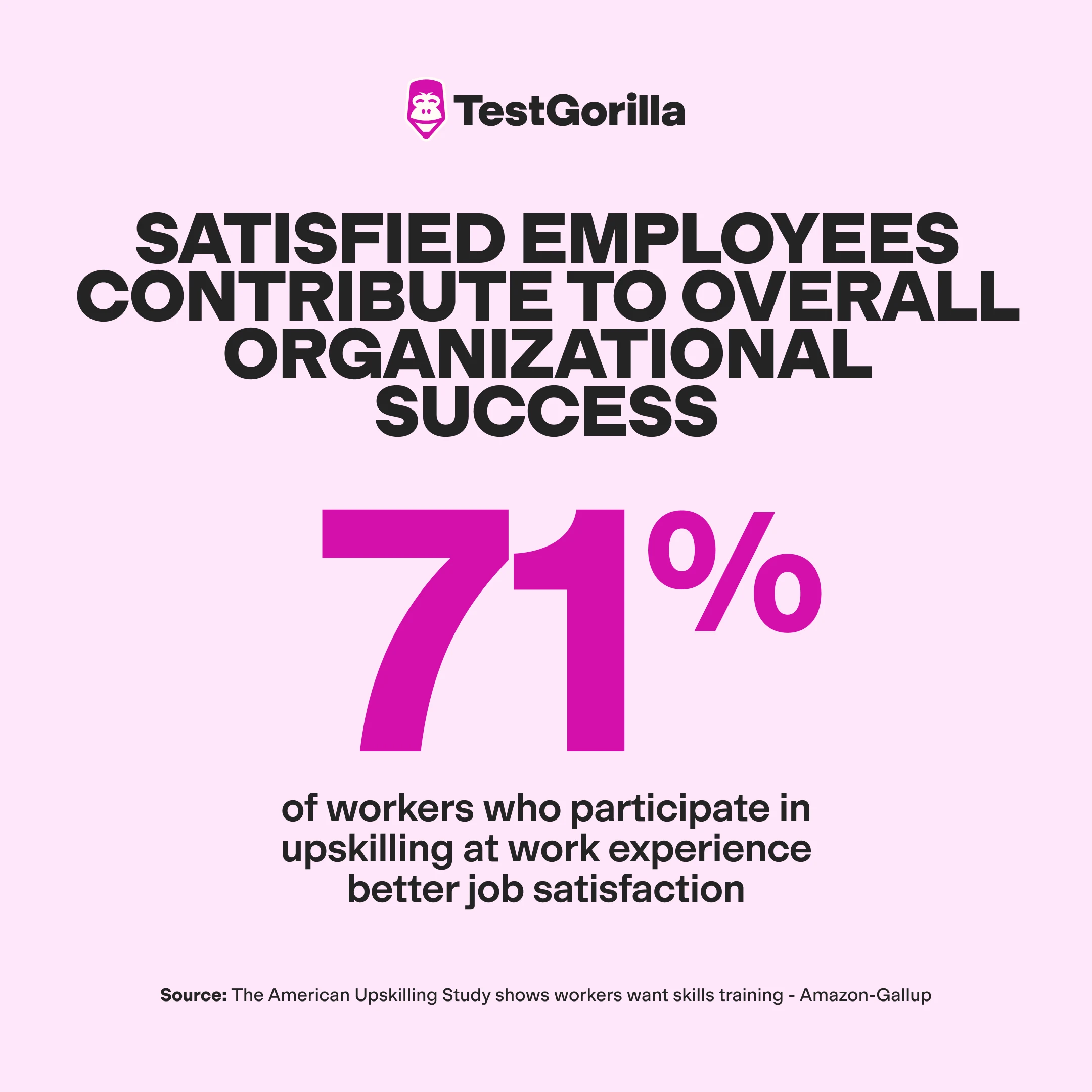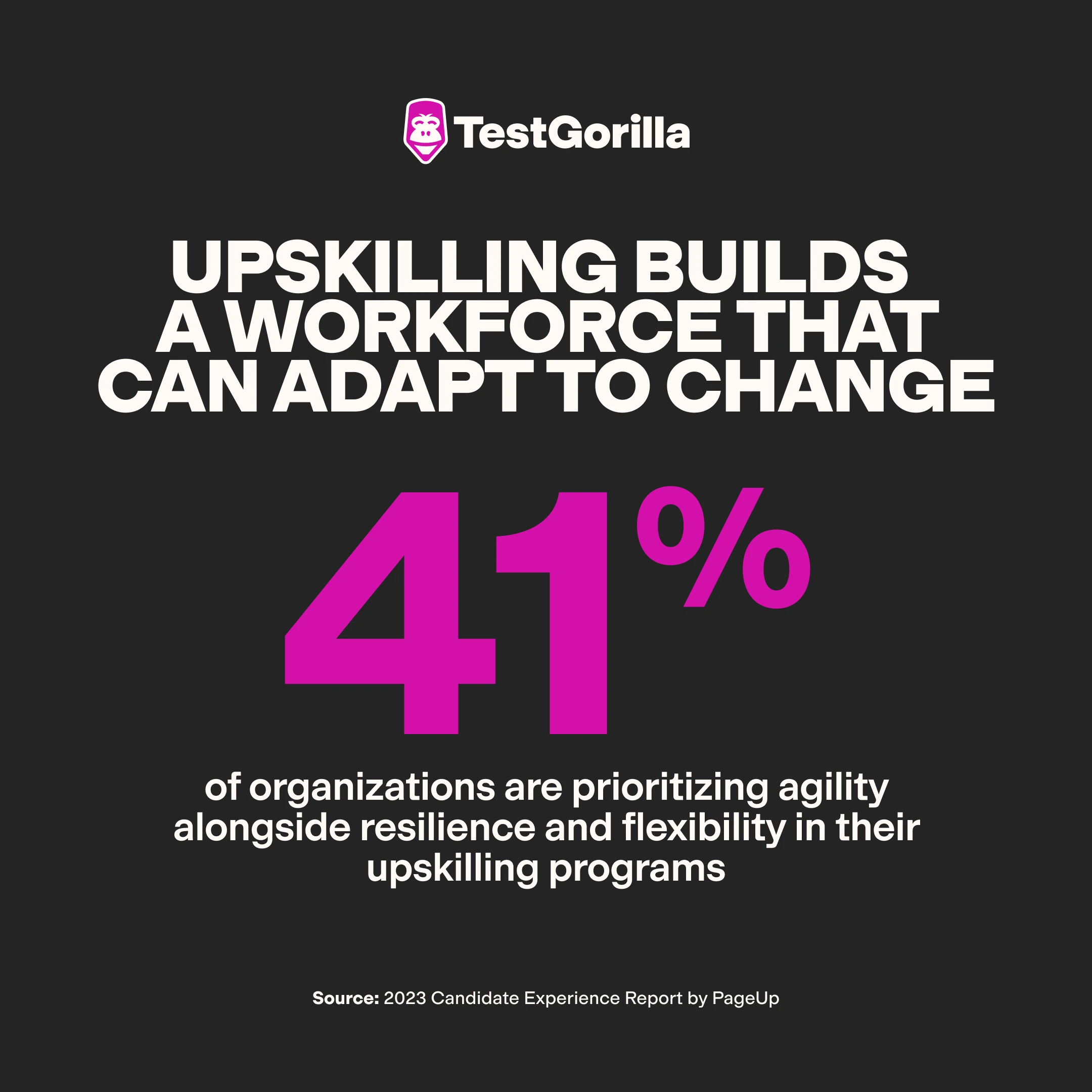Upskilling statistics: Everything you need to know
Change is happening faster and on a bigger scale than ever in today’s workplaces, with technology transforming jobs, workflows, and the skills employees need. It’s more important than ever for employees to upskill – improving what they know or learning something new to stay competitive.
Understanding upskilling statistics is key to making data-driven decisions to future-proof your business. This guide breaks down key upskilling statistics and offers practical tips on creating upskilling strategies for your team.
How we researched this topic
We compiled data from reliable sources such as the World Economic Forum and HR experts to provide up-to-date statistics on upskilling and insights into developing upskilling strategies for your business.
Key takeaways
Upskilling is no longer a choice – it’s a necessity. The rapid adoption of advanced technologies in business is reshaping labor demands, transforming job roles, and creating an increased need for different skill sets.
It’s better and more cost-effective to upskill current employees than to hire external talent to fill skills gaps. 70% of US hiring managers prefer it!
Upskilling also increases retention and employee satisfaction.
Companies that focus on developing effective upskilling initiatives are in a stronger position for long-term success.
A clear plan is key to successful upskilling. This means finding skill gaps, creating specific programs, and improving them over time.
6 key upskilling statistics
1. 23% of jobs will change by 2027
Employers who responded to the World Economic Forum’s 2023 Future of Jobs Survey expect almost a quarter of their roles to change significantly in the next four years. To prepare for this, companies will need a workforce with a fundamentally different skill set from what they currently have.
This leaves employers with two options: hire externally or invest in upskilling their current workforce. Upskilling is the most cost-effective choice because it allows employers to retain workers and avoid the costs of hiring and onboarding new employees.
2. 57% of US employees express strong desire for employer-provided upskilling
In a survey by Amazon and Gallup, more than half of respondents said they would be “very” or “extremely” interested in upgrading their skills or learning new ones if their employer covered the costs. While 38% admitted they were interested in upskilling to change their career, the majority (59%) expressed interest in advancing within their current position.
3. 71% of workers who participate in upskilling at work experience better job satisfaction
According to the Amazon-Gallup survey, most employees feel more satisfied after completing an upskilling program.
It’s not difficult to see why. Upskilling opportunities make employees feel more valued and motivated, which has several advantages. Satisfied employees create positive work environments, improving overall employee morale. They’re typically more engaged in their work, too, which boosts productivity. As a result, companies experience less absenteeism and increased retention, contributing to overall organizational success.
4. AI could displace hundreds of millions of jobs worldwide
Goldman Sachs Research estimates that artificial intelligence (AI) could partially automate up to two-thirds of current jobs and replace up to 300 million jobs worldwide. But despite this, the think tank notes that technological innovations like AI have historically created new jobs.
Moreover, Hadi Partovi, CEO and founder of Code.org, says the real risk isn’t losing jobs to AI itself but losing jobs to people skilled in using AI. While some jobs will disappear, others will incorporate AI. This means organizations will need employees with the skills to work with AI technologies.
5. Gen Z values skill development more than salary
According to Handshake’s Network Trends report, 63% of Gen Z see skills development as a marker of career success, compared to just 51% who chose a high salary as a key indicator.
When it comes to what type of skills development, role-specific skills (52%) are more valuable to Gen Z than general skills development (35%).
By 2030, Gen Z will make up about 30% of US employees, so aligning workplace strategies to their priorities will be critical for retaining this generation and future-proofing organizations.
6. Only 5% of executives strongly believe they’re investing enough in upskilling
Despite more than three-quarters of executives believing that companies should develop their employees’ skills, a Deloitte survey found that only 5% believe they invest enough resources to keep workers’ skills up-to-date.
This leaves an overwhelming 95% in danger of having a workforce that’s increasingly obsolete.
When asked, 65% of employees said that the skills they need to do their jobs had changed in the preceding two years. With roles evolving so quickly, companies must prioritize upskilling for long-term success.
Why upskilling matters
In 2024, 45% of organizations put more resources into upskilling their employees. Beyond closing skills gaps, upskilling helps companies achieve long-term success through:
Increased employee retention: Investing in boosting employees’ skills shows a company’s commitment to its staff, which fosters loyalty. Furthermore, companies that prioritize skills are 98% more likely to retain high-performing employees.
A more agile workforce: Upskilling builds a workforce that can adapt to changing business practices and needs. This attribute is so critical that 41% of organizations are prioritizing agility alongside resilience and flexibility in their upskilling programs.
Increased employee engagement and satisfaction: When given the opportunity to develop their skills, employees are better equipped to do their jobs and may see a clearer path for growth within the company. As a result, they tend to be more enthusiastic and motivated about their work. This helps create a stronger company culture and enhances employee satisfaction.
Improved productivity: Skills development keeps employees capable of performing their roles as expectations evolve. Combined with the benefit above, this significantly improves overall productivity.
The best insights on HR and recruitment, delivered to your inbox.
Biweekly updates. No spam. Unsubscribe any time.
The cost of not upskilling
Upskilling is more important than ever in today's business landscape. According to the Columbia Business School, the scale of the impact that AI and big data technologies are having on modern jobs is “almost as transformative to the economy as the Industrial Revolution.”
McKinsey predicts that by 2030, generative AI will automate up to 30% of current hours worked, causing up to 12 million occupational transitions. However, Deloitte has found that just 2% of organizations have a long-term strategy for AI’s effect on their workforce, and the majority (58%) have only just started to consider the impact it will have.
Companies that don’t ensure their workforces can adapt risk falling behind in an increasingly competitive market. They’ll find themselves with an unprepared workforce, massive skills gaps, and skyrocketing turnover rates.
Having to hire new talent with the skills to meet changing demands is the most expensive consequence of all. In 2024, the average cost of turnover was $36,295 per employee, and over 20% of hiring managers estimated costs of $100,000+ for specialized roles. Companies that invest in upskilling save on these recruitment costs and ensure employees stay productive.
4 best practices for implementing an upskilling strategy
These four tips can help ensure your upskilling strategy is a success:
1. Identify skills gaps in your organization
A skills gap analysis is the foundation of an effective upskilling strategy. If you skip it, you risk wasting time and resources on training programs that don’t give your employees the knowledge they need.
However, most HR professionals and decision-makers feel their companies fail to effectively identify the skills gaps between their current employees and future business needs. Just 15% say their company is “highly effective” at this.
To identify skills gaps across your workforce, conduct a thorough skills assessment. Follow these steps:
List the skills your business needs based on its goals. For instance, if your business is focusing on digital transformation, these might include data analytics, technology literacy, knowledge of AI systems, and critical thinking.
Measure your employees’ skills using surveys, performance review data, and talent assessments (like TestGorilla’s). Create a list of these skills and, if possible, how many employees possess them. For example, you might find through a talent assessment that only 30% of your team is skilled in data analytics.
Compare the lists to see where your team’s current skills don’t align with what your business needs.
2. Avoid a one-size-fits-all approach
While employees want employer-provided upskilling, 68% don’t believe a one-size-fits-all approach will meet their needs. Targeted retraining focused on employees’ unique weak spots is far more effective.
A thorough skills assessment, as we’ve covered above, can give you the insights you need to create tailored upskilling programs. For example, say a handful of employees show a gap in their cloud computing skills. You can enroll them in AWS or Microsoft Azure courses to build expertise.
Likewise, perhaps some of your team struggles with conflict resolution, and others lack knowledge of advanced cybersecurity strategies. You can design separate training programs for these employees or offer funding for certification courses.
3. Build a culture of continuous learning
A culture of continuous learning is essential for preparing employees to adapt to change and thrive in the future. It also highlights that upskilling isn’t a one-and-done matter.
To promote a culture of continuous learning:
Lead by example: Managers who actively engage in learning opportunities set a powerful precedent for their teams, getting them excited about upskilling.
Create opportunities to share knowledge: To encourage collective growth, have employees collaborate through peer-to-peer learning sessions, team workshops, or mentorship programs.
Support career development: Offer clear pathways for advancement tied to skill development, such as internal promotions, role-specific training, or certifications.
4. Regularly assess and update your upskilling strategy
Technologies evolve, business priorities change, and markets shift, so it’s vital to review and update your upskilling strategy regularly. Here’s how you can do it:
Track key performance indicators (KPIs) like employee productivity, retention rates, and job performance to evaluate the impact of your upskilling programs.
Stay updated on technological and industry advancements that may impact your business’s skill requirements and, therefore, its upskilling strategies.
Gather employee feedback – such as through surveys or informal check-ins – to see how effective your upskilling strategy meets their needs.
Compare your upskilling strategy to your current business goals – especially if they’ve changed or expanded since you implemented the strategy.
Refine and adjust your strategy based on the information you gather.
Level up your hiring process with talent assessments
Current upskilling statistics highlight the importance of having a workforce with the skills to drive your organization to success. This starts with hiring the right talent.
Talent assessments, like those offered by TestGorilla, go beyond resumes to give you deep insights into candidates’ job-specific skills, cognitive abilities, personality traits, and more. They help you identify talent with the exact technical and professional expertise your team needs. Plus, you can spot the candidates with the right behavioral traits to push innovation and growth at your company.
With more than 400+ tests in our library, TestGorilla enables you to combine up to five tests tailored to your organization’s specific needs.
Sign up for your free TestGorilla account to start building stronger teams today.
FAQs
How much does upskilling cost?
The costs of upskilling vary depending on factors such as industry, role, and type of training. According to the World Economic Forum, the average cost of upskilling US workers from now until 2029 will be $24,000 per displaced employee.
Why is upskilling important?
Upskilling is important because it bridges skill gaps, improves employee retention, and ensures companies remain successful in the face of changing demands.
What is the effectiveness of upskilling?
Upskilling is an effective strategy for long-term business success. It allows companies to bridge skills gaps, develop a culture of learning, and save on recruiting and onboarding.
You've scrolled this far
Why not try TestGorilla for free, and see what happens when you put skills first.

















